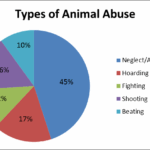The harrowing reality of animal cruelty is a pervasive issue, transcending geographical, cultural, and socioeconomic boundaries. Disturbingly, estimates suggest that millions of animals succumb to acts of cruelty each year, whether due to deliberate abuse, neglect, or exploitation. Understanding the scope of animal cruelty requires examining the various types of cruelty that exist, along with a regional breakdown of these tragedies. This analysis seeks to shine a light on the numerous facets of this grim reality.
Firstly, it is imperative to delineate the types of animal cruelty that manifest in society. These can be broadly categorized into intentional harm and neglect. Intentional harm encompasses direct acts of physical violence, such as beating, stabbing, or shooting animals. Such actions are often fueled by anger, psychopathy, or cultural beliefs that devalue animal life. Neglect, on the other hand, involves the failure to provide necessary care, including food, water, shelter, or medical assistance. The latter often results in distressing consequences, leading to suffering and, ultimately, death.
Within the spectrum of animal cruelty, specific categories merit particular attention, namely domestic animals, farm animals, wildlife, and animals used in entertainment. Each type of animal faces unique challenges, and understanding these nuances contributes to a more comprehensive understanding of the crisis.
Starting with domestic animals, which include household pets such as dogs and cats, studies indicate that millions are victims of cruelty every year. This category encompasses a wide range of abuses, from animal fighting rings to abandonment. In urban areas especially, the number of strays is staggering, exacerbated by negligent pet ownership and inadequate enforcement of anti-cruelty laws. As a result, these animals suffer chronic conditions leading to premature death.
Moving on to farm animals, the sheer scale of suffering is astonishing. An overwhelming majority of farm animals—such as pigs, cows, and chickens—endure a life of confinement, often in deplorable conditions. Industrial practices frequently result in overcrowding, disease, and malnutrition. A significant percentage—estimated in the millions—are not just neglected but are subjected to systematic cruelty, including inhumane slaughtering methods that cause undue suffering and death.
Wildlife, too, finds itself in peril due to human actions. From illegal poaching to habitat destruction, animals like elephants, tigers, and rhinos face a variety of threats leading to their decline. While precise figures are difficult to ascertain, estimates suggest that thousands of wild animals are killed each year, driven by the insatiable human demand for trophies, traditional medicines, and exotic pets. The intricate web of biodiversity that these animals contribute to is irrevocably altered with each act of cruelty, impacting entire ecosystems.
The entertainment industry is not innocent either; countless animals suffer in the name of entertainment, whether in circuses, marine parks, or zoos. This group, often referred to as “performing animals,” endures confinement, harsh training techniques, and unnatural living conditions. An examination of such practices reveals that while some animals may survive, many succumb to the damaging effects of stress and mistreatment, leading to untimely deaths.
Geographically, the prevalence of animal cruelty differs significantly across regions, influenced by cultural attitudes, legal frameworks, and economic conditions. For instance, in developed nations, while there are stricter animal welfare laws, instances of cruelty continue to be reported at alarming rates. Urbanization and the human-animal bond that falters amid modern lifestyles contribute to high rates of domestic animal neglect.
Conversely, in developing countries, where resources for animal protection are limited, the fate of stray animals and livestock often hangs in the balance. In certain regions, cultural practices may contribute to cruelty, particularly in the context of traditional events or rituals that involve harm to animals. Efforts to reform these practices face considerable resistance, complicating the task of protecting these vulnerable creatures.
The culmination of these various factors results in staggering numbers: millions of animals lose their lives annually due to cruelty in its myriad forms. Recognizing these figures, as grim as they are, can serve as a catalyst for change. Increased awareness fosters compassion and, ultimately, societal transformation.
The responsibility of addressing animal cruelty rests not only on organizations and policymakers but also on each individual. Advocacy, education, and grassroots movements play pivotal roles in transforming societal attitudes. Legislation aimed at bolstering animal welfare laws and their enforcement remains essential. However, lasting change necessitates a cultural shift towards recognizing and respecting the intrinsic value of all living beings.
In conclusion, the staggering statistics surrounding animal cruelty underscore an urgent need for action. The suffering of millions of animals, whether in domestic settings, farms, wildlife habitats, or entertainment venues, is a dire reality that demands attention. Moving forward, vigilance, education, and advocacy can pave the way for a future where animal cruelty is significantly diminished, favoring a compassionate coexistence with all creatures. As we strive to elevate the treatment of animals within our society, the collective voice against cruelty can roar louder, fostering a world that cherishes and protects those who cannot advocate for themselves.






